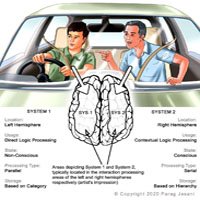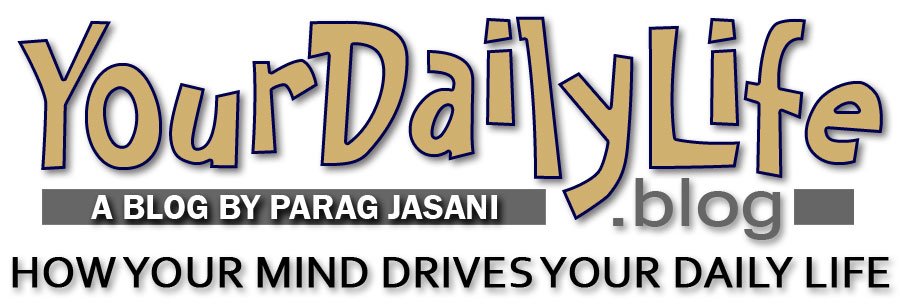Although it’s not known to science, the core reason we have two hemispheres in the brain is that in order to optimize our interactions, both of them need to process our ongoing interactions in two different ways.
As per the Dichotomized Operating System model 1:
The left hemisphere, which I call system 1, uses direct logic and the right hemisphere, which I call system 2, uses contextual logic to process our interactions 2.
To understand how our mind works, we must understand how they work as a single system, which can best be done using the “Car Treasure Hunt” analogy, as follows.
A father and his son are participating in the game of “Car Treasure Hunt” with the son at the driving seat. Car treasure hunt is a game where each person or team attempts to be the first in reaching a destination using a trail of clues while travelling in their car.
The son is good at thinking logically and executing efficiently, as he is young and physically fit. He avoids cars, people crossing roads, etc. and follows traffic lights, diversions, etc. on his own, but consults his old father, who is not as physically capable and is not as strong in logical processing as his son, but possesses wisdom derived from decades of experience of city roads, locations, their histories, features, dangers, shortcuts, etc., which he uses to decode clues given in the game for different destinations to guide his son on which path to take.
The Analogy:
In the analogy, the father is system 2, which is what we call “the self”, and the son is system 1, which is our unconscious mind 3.
In the way father and son work as a team to reach common goals, system 1 and system 2 work in the brain as a team to reach common goals.
As avoiding other cars, people crossing roads, etc. and following traffic lights, diversions, etc. are based on preset instructions, the son does not need to consult his father on how to deal with them and executes them on his own. In the same way, system 1 executes repetitive, condition based, hard-wired, etc. tasks, which are preset tasks, on its own, which corresponds to unconscious processing in the brain.
The way the son consults his father when judgement is to be made on navigation, system 1 consults system 2 when judgement is to be made on how to interact further using past data from its hierarchical database, which corresponds to conscious processing in the brain.
Decision Making
In the process of making a decision…
- The son (system 1) and his father (system 2) generate one or more decisions on the ongoing interaction using logic and experience using past data from its hierarchical database respectively, out of which…
- The father (system 2) evaluates the decisions generated by his son (system 1) and himself
- He (system 2) judges which decision is suitable for execution using simple logic
- He (system 2) takes his son’s (system 1’s) assistance when complex logic is involved
- Based on which, he (system 2) finalizes the decision he finds appropriate for execution (which translates to the self finalizing the decision for execution) which we call “intention”
- When his son (system 1) is highly confident about something, based on the degree of such confidence, he (system 2) refrains from making and/or executing decisions and follow his son (system 1)
Executing a Decision
In the process of executing the finalized decision, i.e. intention…
- The father (system 2) initiates execution of the finalized decision as and when required
- He (system 2) deliberates and if and when required, communicates with his son (system 1) in the execution process
- He (system 2) guides his son (system 1) in execution of physical actions (e.g. giving directions), in which…
- When repetitive physical actions are involved, his son (system 1) executes them on his own (e.g. keeping the car on the right side of the road)
- When condition based physical actions are involved, his son (system 1) executes them on reaching such conditions (e.g. stopping at the red light)
Fundamental Mind Related Phenomena
System 1 & 2 and their relation to our fundamental mind phenomena:
System 2 is what we refer to as ‘self’.
System 1 is the unconscious mind.
Thoughts are communication within and between system 1 and system 2.
Decisions result out of system 2’s processing with system 1 and/or itself.
Judgments are decisions finalized by system 2.
Intentions are action plans based on system 2’s finalized decisions.
Attention is about the topic that is being processed by system 2.
As system 1 processes interactions using parallel processing, it is much faster than system 2, which processes interactions using serial processing.
To verify the above points, all you need to do is to compare them with your subjective experiences. You do not need a science lab for that.
References
1 Dichotomized Operating System Model (DOS Model) is a functional model developed by me which reveals a single system consisting of hierarchically interconnected goal-driven mechanisms and processes running in the brain that work together and form what we collectively call “mind”, including how the “self”, which has no physical dimensions, is not visible and does not weigh anything controls our thoughts, decisions, actions, attention, behaviour, personality, etc. and is responsible for our existence.
It is the only existing fully causal account of the human mind and is based on the process of Natural Selection proposed by Charles Darwin in the year 1859 in his book “On the Origins of Species – By Means of Natural Selection”.
It brings upon a new paradigm in mind and brain sciences based on the “systems thinking” approach.
2 For those who have read or are familiar with the book “Thinking Fast and Slow” by the Noble Laureate Daniel Kahneman:
1) Although Kahneman has stated in his book that he has used the terms system 1 and system 2 as metaphors to make it easy to explain the decision making process in the brain, the DOS model not only explains the presence of such systems, but how they work together and form our mind.
2) Kahneman’s explanations are based on ideas and observations, whereas DOS model is based on fully causal explanations stemming out of the process of natural selection.
3) DOS model also explains mechanisms responsible for each of Kahneman’s observations, which claim that system 1 is fast, automatic, impulsive, associative, emotional unconscious, etc. and system 2 is slower, conscious, reflective, deliberative, analytical, rational, etc.
4) In this short video, Daniel Kahneman talks about system 1 and system 2.
3 The degree of consciousness, i.e. the state of being subconscious, is when an interaction is distributed between system 1 and system 2. Its degree is based on distribution between them. The more it is processed by system 2, the higher the level of its consciousness.


11 Comments to “
Essential 1: The Fundamentals
How Mind Emerges from the Brain
The simplest explanation of your existence
”